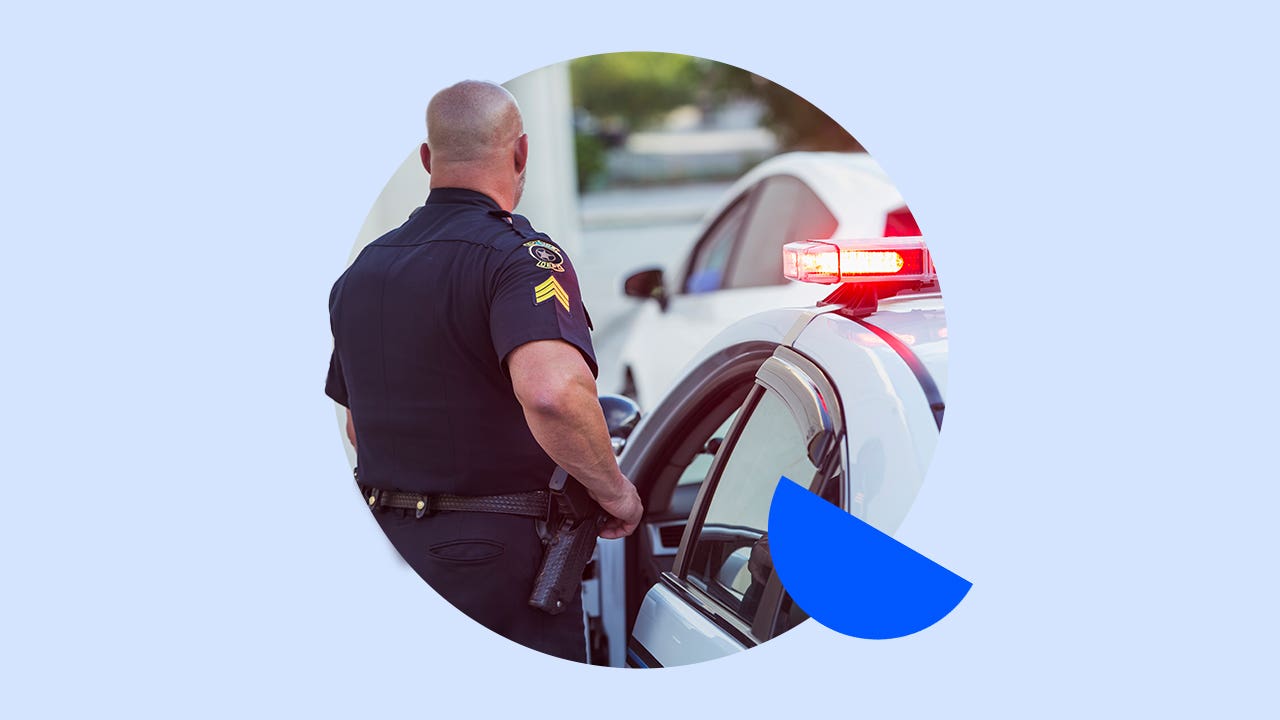How a speeding ticket impacts your insurance in Oregon

Oregon drivers pay an average rate of $1,920 per year for full coverage car insurance, while state-mandated minimum insurance averages $788. A single speeding ticket, however, can increase your rate by more than 20 percent—with multiple tickets likely leading to even further increases. Why? Insurers base rates on their estimation of risk, and drivers who have a speeding conviction on their record may be considered riskier drivers. Bankrate’s insurance editorial team took a close look at Oregon’s insurance regulations to help you understand how a speeding ticket can impact your insurance costs.
How much is a speeding ticket in Oregon?
Like most states, Oregon has legal requirements for all drivers to carry a minimum amount of car insurance in order to be legal when behind the wheel. Drivers with a clean driving record are likely to pay the lowest rates for that minimum coverage, as well as for any higher-than-minimum levels or optional types of insurance they purchase.
As we noted above, the average rate for full coverage in the Beaver State is $1,920, while minimum coverage averages $788. These rates are for drivers with no marks on their license, though. After a speeding ticket, the average rate for full coverage increases to $2,363—a 23 percent increase—while minimum coverage increases by 21 percent, to $956.
Oregon classifies speeding tickets based on how far over the speed limit you were driving when ticketed. Below is a breakdown of Oregon speeding ticket fines according to class and fine type. Please note that local counties can add a surcharge of $5 to each fine.
- Class A (30 miles or more over the speed limit): $225-$2,000
- Class B (21-30 miles over the speed limit): $135-$1,000
- Class C (11-20 miles over the speed limit): $85-$500
- Class D (1-10 miles over the speed limit): $65-$250
Drivers who speed in special areas such as construction or school zones may have increased fines, between $225 and $875, depending on how fast they were going.
A driver caught speeding 30 mph or more above the speed limit may receive a license suspension of up to 30 days if they have another speeding violation within 12 months. Driving 100 mph or more over the limit is considered reckless driving and could have a fine of $1,150, plus a mandatory 90-day license suspension.
The cheapest car insurance for Oregon drivers with a speeding ticket
When looking for cheap car insurance in Oregon, a speeding ticket is just one of the factors that your insurer is likely to consider when determining your rate. Carriers will also look at your car’s age, make and model, as well as your location, age, credit history and more. Even with a ticket, you may be able to find affordable coverage by choosing a company known for writing inexpensive policies for individuals with marks on their license. You may want to consider asking for quotes from one of the following insurance companies known for writing cheap policies for drivers with tickets:
| Company | Rate before speeding ticket in Oregon | Rate after speeding ticket in Oregon | % diff. from Oregon rate after speeding ticket |
|---|---|---|---|
| Auto-Owners | $1,274 | $1,511 | -36% |
| Encompass | $1,470 | $1,685 | -29% |
| Travelers | $1,312 | $1,701 | -28% |
| Mutual of Enumclaw | $1,340 | $1,747 | -26% |
| Progressive | $1,377 | $1,755 | -26% |
*All rates displayed are average annual full coverage rates.
What to do after a speeding ticket in Oregon
After a speeding ticket in Oregon, you have several options open to you. Depending on the path you take, you may be able to keep a rate increase to a minimum. It’s worth noting, too, that the ticket will only stay on your record for a period of several years. After this time, if you have maintained a clean record in the interim, your rate may drop.
Fight the ticket
If you feel you were given a ticket in error, you may choose to go to court to fight it. Oregon classifies tickets in one of three categories: presumptive, minimal and maximum fines. The presumptive amount is what a driver pays if they choose not to fight the ticket, and it’s usually more than the minimum but less than the maximum fine. If they do go to court, they could be given either the minimum or maximum fine, or could have the fine reduced or waived. You could also consider hiring legal counsel to represent you; it’s possible that the costs associated may be lower than the maximum fine plus the impact on your car insurance.
Get quotes from other car insurance companies
One of the best strategies for saving money is to shop around and compare quotes from multiple carriers. This will tell you which carrier provides the cheapest rates based on your driver profile. Every insurer uses its own proprietary algorithms to determine rate, so the quotes you receive from several insurers are likely to be different. Just be sure you are asking for the same types and levels of coverage from each carrier, so you can do an apples-to-apples comparison.
Modify coverage selections
Whether you stay with your current carrier or make the switch, modifying coverage selections is another way to save. You may be able to increase deductibles with comprehensive and collision coverage, which could lower the cost of your premium. However, proceed with caution, as you’ll be required to pay more out of pocket in the event of a covered collision or comprehensive claim.
After reviewing your policy, you may also realize you have optional coverage types that you no longer need, such as gap insurance or roadside assistance. To reduce your insurance expenses, you might consider dropping these. Speak with your agent to determine which coverage types are essential for you.
Review all available discounts
Discounts are another easy way to save and most carriers offer quite a few. Many offer potential savings for bundling policies, adding multiple vehicles to the policy and maintaining good grades. However, some carriers offer options you may not be as familiar with, such as a new car discount or green vehicle discount.
Frequently asked questions
-
To find the best insurance company, including for drivers with speeding tickets, be sure to compare quotes from multiple providers. Not only does this give you a snapshot of the lowest rates for you, but it also narrows down which carrier has the coverage options you want. You should also consider your priorities when looking for coverage. If you have a teen in your family, for example, you may want to work with a company known for writing inexpensive policies for young drivers. If you work from home or are retired, a low-mileage policy may give you the best coverage. Considering your circumstances can help you make the right decision for your family’s needs.
-
Finding coverage after your first speeding ticket in Oregon shouldn’t be difficult. Most carriers are likely to have no problem with providing you with coverage, although you may pay more than a driver with a clean record. If you have multiple infractions on your license, however, some insurers may consider you a high-risk driver—and not all companies write high-risk policies. Fortunately, there are several companies known for writing affordable high-risk driver insurance, so you should still be able to find coverage that works for you.
-
Oregon does not state how long a speeding ticket will stay on your record, however the average for many states is three years. Your insurer may also have policies regarding how long it will consider your speeding ticket when determining your rate. After that period, if you have maintained a clean record, you may see a decrease in your premium.
-
One of the most important factors insurers consider when determining rates is your driving record. If you can improve your driving skills after your ticket and maintain a clean record, your rate may drop. Some insurers offer a discount to drivers who take a defensive driving course to help improve their skills. If your driving skills are generally good and you consider yourself a safe driver, a telematics program through your insurer may also net you a considerable discount—up to 40 percent off for some insurers. Keep in mind that some insurers may also raise your rates, so talk to your agent to find out if that is a possibility.
Methodology
Bankrate utilizes Quadrant Information Services to analyze May 2024 rates for all ZIP codes and carriers in all 50 states and Washington, D.C. Rates are weighted based on the population density in each geographic region. Quoted rates are based on 40-year-old male and female drivers with a clean driving record, good credit and the following full coverage limits:
- $100,000 bodily injury liability per person
- $300,000 bodily injury liability per accident
- $50,000 property damage liability per accident
- $100,000 uninsured motorist bodily injury per person
- $300,000 uninsured motorist bodily injury per accident
- $500 collision deductible
- $500 comprehensive deductible
To determine minimum coverage limits, Bankrate used minimum coverages that meet each state’s requirements. Our base profile drivers own a 2022 Toyota Camry, commute five days a week and drive 12,000 miles annually.
These are sample rates and should only be used for comparative purposes.
Incidents: Rates were calculated by evaluating our base profile with the following incidents applied: clean record (base) and single speeding ticket.




